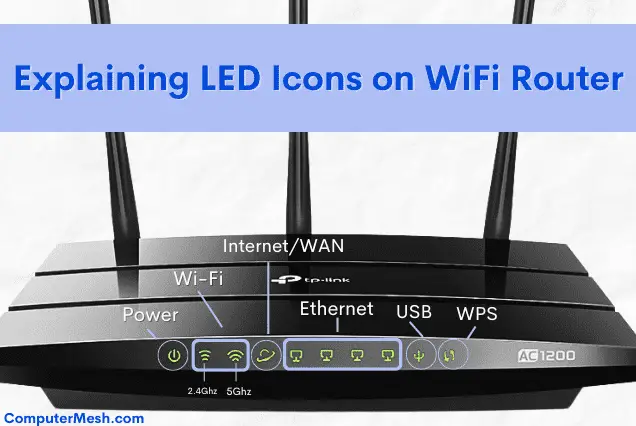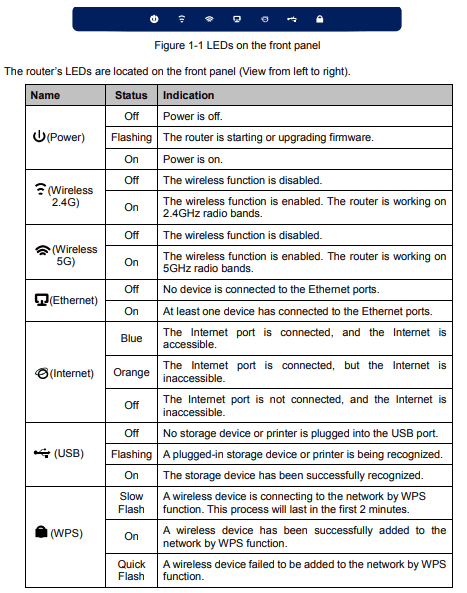Explaining LEDs Light on WiFi Router.
On many occasions, we do not pay enough attention to our WiFi router, and if we look at it carefully, we will see that it flashes some LEDs. The LED lights on the router indicate information and help us diagnose problems with our connection.
If they are on, off, flashing or have one color or another, they tell us what is happening with our WiFi network.
In this tutorial, we will understand what each indication means and which lights should be lit or blinking on the router.
Do all routers have the same indications?
Each router model has its different characteristics, so not all routers have the same standard regarding the LED blinks.
The first thing is that there are many different models of routers on the market so it will depend on the model that we find one arrangement or another. Each manufacturer establishes their pattern in this regard, whether or not the lights flicker and their colors.
However, there is a universal system in which all manufacturers use some basic notions, and practically all of them have the same LED lights that can turn green, red or blink to convey the same information visually. The fact that it flashes can be both positive and negative, depending on the case.
What lights are there in the WiFi Router?
If you’re lucky, your router manufacturer may have labelled each LED with an icon or name to describe what each light means for recognition, even in low-light conditions.
For example, there may be a WiFi icon as WLAN or as “Power.” In this case, a constantly lit light may mean that everything is working fine, and a flashing light may mean that there is some connection problem.

Power light
The power indicator light is usually a circular icon that indicates the router’s power status.
Different states and their meanings:
- Solid green or blue: Indicates that the router is connected to power and operating normally.
- Solid red: Indicates that the router is connected to power, but there is a problem.
- Off: Indicates that the router is not connected to a power source or the power switch is not turned on.
If the power indicator light fails to turn on, it indicates a lack of access to the electrical grid, as I said. The initial step in such situations is to ensure that it is properly plugged in. Some models may even be connected to the socket but have a button to turn it on, so we must check that it is not simply turned off.
When it shows a red light, check if the power adapter is working correctly and try replacing it.
Internet/WAN port light
The Internet/WAN (Wide Area Network) is a global computer network or simply the “Internet” indicator light, which is typically a globe icon that indicates the router’s connection from an external network.
Once the device is turned on, it is the most important light since just by seeing it, we can identify if the device has an Internet connection and the state in which it is located.
Different states and their meanings:
- Steady green: Indicates the WAN port is connected to the Internet and operating normally without any problem.
- Solid yellow: Indicates that the WAN port is connected to the Internet or there is a connection issue.
- Blinking green: Indicates the WAN port is sending or receiving data.
- Blinking yellow or not blinking: Indicates there is a data transfer issue, which may be caused by network congestion or connectivity issues.
You can do the following things when the WAN light does not flashes:
Check whether the network cable is connected properly and whether the cable is damaged.
Check if the router’s LAN and WAN port settings are correct, including the IP address, subnet mask, and gateway.
Try restarting your router and modem (if available).
WLAN (Wi-Fi LAN)
The wireless signal light is usually an antenna icon that indicates the strength of the Wi-Fi signal also whether the router is transmitting.
Different states and their meanings:
- Steady green: Indicates that the signal is being emitted without problems, and if it flashes, in some routers it means that, just a data exchange is taking place.
- Off: Indicates that the WiFi is not turned on or no data is being broadcast.
When the light of antenna icon if switched off, check if your router’s wireless network settings are correct. Try restarting your router and connected devices.
Also, not that some routers both support the 2.4 GHz and 5 GHz Wi-Fi bands and can have 2 LED lights separately.
LAN (LAN 1, 2, 3, 4)
The Ethernet/LAN port indicator light indicates the status of the router’s wired connection. Routers typically have multiple LAN ports along with multiple LAN icons that can be used to connect various devices.
In many router models, they incorporate light for each Ethernet port available to connect a cable. Therefore, these will act depending on whether the port is in use or not. These may vary in position, while some models have them on the front of the devices, others have a small LED within the port itself.
Different states and their meanings:
- Steady green: Indicates that the LAN port is connected to a device and is working properly.
- Solid yellow: Indicates a problem with the LAN port connection. This may be due to a bad Wi-Fi cable cable connection or device malfunction.
- Solid red: Indicates that the LAN port cannot successfully connect to the device.
- Blinking green: Indicates that the LAN port is sending or receiving data.
- Flashing yellow: Indicates a problem with data transfer. This may be due to network congestion or connectivity issues.
- Blinking red: Indicates there is a problem with your device that needs to be checked and repaired.
WPS Light
QSS or WPS (Wi-Fi Protected Setup) – makes it easier for external devices to connect to a Wi-Fi point without having to enter a Wi-Fi password.
This is a system that, despite its benefits, can pose security problems, which is why many companies choose not to include it in their devices.
This option, although many devices no longer include it, is still present in many others, and in some models, you can proceed to deactivate or activate it as you wish from the router configuration.
In the case of the LED indicator, it will turn on when WPS is active on the device; if it flashes, it may mean that someone is trying to connect with this method or off if this function is deactivated.
USB light
The USB light indicates the status of the USB interface. USB ports are not available on all routers since not all of them incorporate a USB connector to directly install devices, such as hard drives, printers, and pen drives, among others.
Different states and their meanings:
- Solid green: Indicates that the USB port is connected to a device and is working properly.
- Off: Indicates that the USB port is not connected to a device or there is a connection problem.
For troubleshooting, check whether the USB device is connected properly.
Also check if the router’s USB settings are correct and restarting your router.
However, some models have USB and do not have this type of LED indicator. It is an aspect that you should also take into account.
If the router supports GPON technology (connection via a fiber optic patch cord, not Ethernet), two more indications, LOS and PON, are added to it instead of WAN:
- LOS – responsible for the existence of the connection;
- PON – is responsible for registering the router in the provider’s network.
Orange Light of WAN
This indicates that the cable from the provider’s network equipment is either connected but not accessible or damaged. Begin by inspecting the WAN port connector for any looseness; it may have simply become detached.
If the connector is securely in place but the Internet icon remains unlit, try restarting the device. Persistent issue? Call your provider’s technical support.
Though uncommon, a burnt-out WAN port is a possibility. To test its functionality, use an Ethernet cable connecting the PC to the modem and switch it from the LAN port to the WAN port. If the indicator turns green, the port is operational.
What indication should be on the router?
How many lights and buttons should be on the router? It all depends on what condition it is in.
Let’s simulate the most likely situation.
The router is connected to all devices, and they receive data packets. Status of the lights that blink and light on the router:
- Power – Steady Lit up
- WLAN (Internet icon) – flashing
- WAN – flashing
- LAN – blinking lit up
- USB – steady lit up if connected to a device otherwise off
After looking at all the icons under the LED on your router and still wondering what the indicators mean, then it’s time to seek help from the device’s manual. You can download a PDF copy of the instructions directly from the manufacturer’s website.
For instance, a screenshot from the manual of Tp Link Archer explaining the ‘status’ and ‘indication’ of the icon on the router.

Conclusion
In most routers, two LED colors can be found. However, on other devices, there are up to 5 different colors: red, green, blue, orange, and yellow. Therefore, the brand of the device itself comes into play.
What is clear is that one of the ways in which we can obtain information about the router’s status is by observing the color of the LEDs. They generally use two colors as we said:
Green means that everything is in order and working correctly.
Red means that an error has occurred or there is a malfunction. In this case it is a symptom that we have a problem in the connection, in the LAN ports or wherever it indicates.
Another aspect we have to observe is whether the router flashes or not. Typically, this is linked to the presence of activity on our local network or Wi-Fi. Therefore, we can conclude that:
If the router flashes, it is usually an indication that there is traffic on our network and that we have some equipment connected.
If the LED light on the router is solid, it means that there are no devices connected.
In summary, understanding the meaning of LED lights on your router can be very useful in troubleshooting any issues you may encounter. By paying attention to their color and behavior, you can get a better understanding of the status of your network and take necessary actions to resolve any problems.
[Related]
